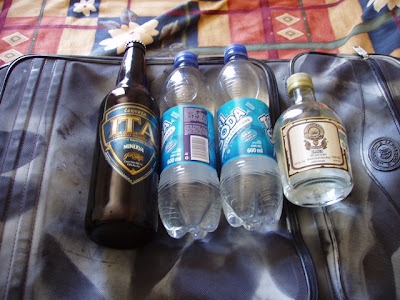 |
| San Antonio |
We wake up every morning to the sound of sweeping, and something that sounds like a cross between a monkey and a rooster. It's the grandmother, the Abue', sweeping up the leaves and bougainvillea blossoms in the garden below with Picotes, her pet crow hopping beside her, chuckling and cawing in what appears to be a vain attempt to mimic the human language and the roosters next door. She shuffles along in her pink bedroom slippers, a long silver braid down her back. He picks up a magenta flower in his beak from the swept pile and the Abue' knocks him aside with her broom and he squawks and flutters his blunted wings at her. It is an endless game they play together, and is becoming as familiar to us as the church bells, the tap tapping of metal at the nearby herraduria, and the ceaseless coo of palomas in the nearby tree branches.
The Abue' never smiles or says buenos dias to us, unlike the old woman in the shop on the corner, who sits day after day in her dark empty store before a table of dried pomegranates, nodding and mumbling to everyone who walks by. One day I went inside and offered her a mango from my bolsa full of produce. Is it dulce? She asked me, and I said that I hoped that it was very sweet. Good, she said, then I will save it for my postre. Her eyes twinkled in that way of old Mexican women who look ancient beyond their years, and I wanted to ask her who she was and what happened to her shop. Intead I just stood there with my bag of fruit and vegetables and then just left, somehow realizing that one mango is not enough to win such confidence. These things take time.
Maneuvering over the broken concrete steps outside, I stumble past a pile of used dog-eared books laid in neat rows on the cobblestones. Poetry books, pulp fiction and philosophy, dusty old encyclopedias, a stack of ancient National geographic magazines. Felipe sits in the doorway of his house, the one with the roosters and puppies and plants in rusty coffee cans vying for space in a tiny dirt courtyard that I can see from my rooftop. He dreams of owning a bookstore one day, but can not afford the rent, because most of his earnings go to medical bills for his six year old daughter who suffers from a kidney disorder. I buy a Mexican cookbook and a Spanish grammar book for Mark, which he will open only once. Why don't you advertise? I ask him. Put a few flyers around, get the word out, rather than depend on the randomness of passersby? But he just shrugs. Poco a poco, he says. Little by little. He is in no hurry, he can wait for the world to find him. There is plenty of time for dreams to come true. I smile as I bite my capitalist tongue, and open the door to my apartment. Wait, says Felipe, holding up a thin, yellow-paged book of Spanish short stories titled Los Angelos Blancos del Delirio- The White Angels of Delirium. You will like this one, he says, and hands it to me, smiling. A gift.
 |
| The street where we live |
Sometimes I feel a little guilty about my own personal struggles, which at times seem to pale in comparison to my neighbors here in la colonia San Antonio, who struggle on a daily basis with health and poverty and yet seem to manage playfulness and dignity and an inner strength that I could only hope to achieve. And yet I see us all sharing a similar human need for purpose and meaning in our lives, whatever form that takes. Even if it is only for ourselves.
A statue of San Antonio himself watches over us from the corner of the church down the street. He rises up above a dry fountain, clutching a pink plastic lily. I used to think it was real, and that the people replaced it with a fresh one every day. It was Mark who quelled my romantic notions and gave me a harsh reality check. In his gentle down to earth manner, and with much rolling of eyes, by telling me 'It's plastic, for godsakes!' And of course he's right. Nevertheless, San Antonio, patron saint of lost and stolen articles, has helped me find my heart, which I perhaps didn't even know I had lost until now. My heart, that stubborn and fearful beast, is being pried open, poco a poco, by every person I meet here in the broken streets of my neighborhood.
Picotes the crow takes the bright bougainvillea blossom to a corner of the garden and buries it beneath a pile of debris. Who knows why he does this? Perhaps in his own feathered way he is finding a purpose, a way of holding on to something beautiful and precious. Or perhaps he is just following an ancient crow ritual or instinct that even he does not understand.
 |
| Picotes |
-posted by Susan













